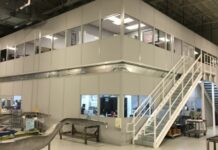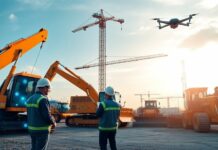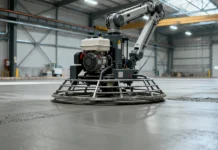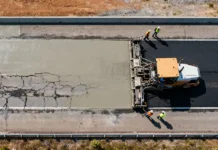The construction industry confronts mounting pressures that threaten project viability and contractor profitability. Labor shortages across skilled trades reach critical levels in many markets, with aging workforce demographics and declining interest among younger generations creating talent gaps that conventional recruiting cannot fill. Project complexity increases while schedule tolerances tighten, demanding precision and efficiency beyond what traditional manual methods consistently deliver. Safety concerns persist, with construction consistently ranking among the most hazardous industries despite decades of improvement efforts. Robotics in concrete construction emerges not as futuristic speculation but as practical response to these present challenges, fundamentally reshaping how concrete work proceeds from initial placement through final finishing.
The Robotic Revolution Across Concrete Operations
Robotic systems now address virtually every phase of concrete construction, each application targeting specific pain points in traditional workflows. Automated concrete placing equipment represents perhaps the most mature category, with laser-guided screeds achieving flatness tolerances impossible through manual methods while dramatically accelerating floor placement. These sophisticated machines combine precision positioning systems with automated concrete distribution, continuously adjusting elevation and material flow to maintain specified profiles. A robotic screed operating on a warehouse floor pour can place and level concrete at rates exceeding manual crews by factors of three to five, completing in hours what might require full shifts using conventional approaches.
Concrete finishing robots handle the labor-intensive process of smoothing and texturing fresh concrete surfaces. Multiple configurations address different applications, from ride-on power troweling machines guided by laser or GPS systems to fully autonomous finishing robots that navigate pours independently. These systems execute finishing passes with consistent pressure and timing, eliminating variations introduced by operator fatigue or experience differences. The precision proves particularly valuable for industrial floors where flatness specifications directly impact operational equipment performance. Advanced finishing robots incorporate collision detection sensors allowing safe operation around obstacles and jobsite personnel, essential capabilities for deployment in active construction environments.
Robotic concrete surface preparation equipment automates demanding tasks traditionally requiring intensive manual labor under challenging conditions. Hydrodemolition robots employ high-pressure water jets to remove concrete with precision unattainable through conventional pneumatic breaking. The technology proves essential for bridge deck rehabilitation and industrial facility maintenance where selective removal must preserve underlying sound concrete. Robotic surface grinding and polishing machines process large floor areas efficiently while capturing dust at the source, improving both productivity and worker health outcomes compared to manual equipment operation.
Reinforcement placement automation addresses one of concrete construction’s most physically demanding and time-consuming operations. Robotic rebar-tying systems navigate bridge decks and building floors, using computer vision to locate rebar intersections and execute ties with consistent quality and speed. These machines can tie thousands of intersections per shift, work that would require multiple skilled ironworkers to accomplish manually. The automation frees craft workers for higher-value tasks requiring judgment and problem-solving while reducing musculoskeletal injury risks associated with repetitive bending and hand tool operation.
Integration of Three-Dimensional Concrete Printing
Concrete 3D printing represents the most revolutionary application of robotics in concrete construction, fundamentally reimagining how structures are created. These systems extrude concrete material through nozzles mounted on gantry frames or robotic arms, building structures layer by layer according to digital models. The technology eliminates formwork requirements entirely, reducing material waste and labor while enabling architectural forms impossible or prohibitively expensive using conventional construction methods.
The practical implementation of concrete 3D printing varies based on project scale and location constraints. Gantry-based systems establish fixed coordinate frameworks spanning the build area, typically used for printing entire houses or substantial structural modules. Robotic arm configurations offer greater flexibility for printing complex geometries or components in factory settings before transportation to jobsites. Both approaches achieve similar fundamental objectives: translating digital designs directly into physical concrete structures with minimal human intervention beyond setup, material supply, and quality oversight.
Construction timelines compress dramatically through 3D concrete printing. Projects report printing structural walls for small residential buildings in 24 to 72 hours, compared to weeks required for conventional framing and masonry. A 140 square meter house in Angola was 3D printed in just 30 hours of machine operation, showcasing the productivity potential when technology and materials align properly. These accelerated timelines must be contextualized within complete construction processes including site preparation, printing system setup, building service installation, and finish work, but the core structural envelope creation demonstrates revolutionary speed.
Material optimization represents another significant advantage of concrete 3D printing. Conventional construction often incorporates excess material for constructability rather than structural necessity, with standardized member sizes and flat surfaces simplifying formwork even when structural analysis indicates less material would suffice. Robotic printing enables topology optimization and functionally graded structures that place material only where engineering analysis indicates it’s needed. This capability can reduce concrete consumption by 30 to 60 percent compared to conventional construction while maintaining or enhancing structural performance.
The technology particularly excels in creating affordable housing at scale, addressing critical shortages in both developed and developing markets. Multiple companies now operate 3D concrete printing facilities producing modular housing units at costs substantially below conventional construction. Hive3D Builders in Texas delivered 800 square foot homes at 106 dollars per square foot using 3D printing, representing significant savings compared to regional construction costs averaging 191 dollars per square foot. As systems scale and experience accumulates, these cost advantages are expected to expand further.
Productivity Gains and Operational Transformation
The quantitative productivity improvements delivered by construction robotics extend across multiple metrics beyond simple task completion speed. Labor efficiency gains range from 30 to 85 percent depending on the specific application and baseline comparison, with the greatest improvements occurring in repetitive tasks previously requiring substantial manual effort. A robotic concrete finishing system might complete in four hours what would require three workers a full shift to accomplish manually, while delivering superior flatness results and eliminating physically demanding labor exposure.
Error reduction and rework avoidance provide less visible but equally important productivity contributions. Robotic systems executing pre-programmed paths with millimeter-level precision eliminate the measurement errors and installation mistakes that plague manual construction. When rebar gets placed exactly as designed, when finishing elevations match specifications precisely, and when concrete surfaces achieve target textures consistently, the avoided costs of correction work and schedule delays create substantial value beyond the immediate productivity of robotic execution.
Workforce optimization enables contractors to deploy human talent more strategically. Rather than assigning skilled craftspeople to repetitive, physically demanding tasks, robotic automation allows these valuable resources to focus on problem-solving, quality oversight, and coordination activities that genuinely require human judgment and experience. A concrete contractor might operate a robotic finishing system with a single skilled operator overseeing multiple machines, freeing other crew members for critical path activities like joint sawcutting, surface preparation, and coordination with subsequent trades.
Extended operating windows provide additional productivity leverage. Robotic systems don’t experience fatigue, can work continuously through environmental conditions that would compromise human performance, and maintain consistent quality throughout extended operations. A bridge deck pour requiring around-the-clock finishing can proceed without shift changes compromising surface quality, while the robotic equipment maintains specification compliance regardless of temperature, lighting conditions, or time elapsed since placement commencement.
Safety Enhancement Through Human-Robot Collaboration
The safety implications of construction robotics extend well beyond simple removal of workers from hazardous tasks, though that benefit alone justifies adoption in many applications. Robotic demolition equipment allows controlled removal of unstable structures from safe distances, eliminating fall risks and structural collapse hazards that make manual demolition work inherently dangerous. Inspection drones equipped with thermal and visual sensors examine confined spaces, elevated areas, and potentially contaminated zones without exposing personnel to associated risks.
The emerging paradigm of collaborative robotics, where automated systems work alongside human crews rather than replacing them entirely, introduces new safety considerations and opportunities. Modern construction robots incorporate extensive sensor arrays that detect nearby personnel and adjust operations to prevent collisions or hazardous interactions. These safety systems, borrowed from industrial manufacturing applications, enable robots to operate at reduced speeds when humans enter designated zones, stop immediately upon detecting unexpected obstacles, and resume normal operations once safe conditions return.
Wearable robotic exoskeletons represent an intermediate category between full automation and traditional manual work, augmenting human capabilities rather than replacing human labor. These devices support workers during physically demanding tasks such as overhead work, heavy material handling, and sustained awkward postures. By reducing the physical forces experienced by workers’ musculoskeletal systems, exoskeletons decrease injury risks while enabling sustained productivity that would be impossible without mechanical assistance. Adoption in concrete construction remains nascent but growing, particularly for reinforcement installation and formwork operations.
Real-time monitoring capabilities inherent in robotic systems contribute to comprehensive jobsite safety management. Robots equipped with cameras and environmental sensors effectively serve as mobile inspection platforms, identifying potential hazards, verifying safety protocol compliance, and documenting site conditions continuously. Integration with broader construction management platforms enables project teams to maintain awareness of site conditions from remote locations, responding to emerging safety concerns before they manifest as incidents.
Economic Considerations and Adoption Trajectories
The economic analysis for robotics adoption in concrete construction involves substantially more complexity than simple equipment purchase costs. Initial capital requirements can be substantial, particularly for sophisticated systems like 3D concrete printers or autonomous equipment requiring extensive supporting infrastructure. These costs must be evaluated against both operational savings in direct labor and materials, and less tangible but equally important benefits including schedule acceleration, quality improvement, and enhanced safety outcomes.
Payback periods vary dramatically based on utilization rates and the specific applications for which equipment is deployed. A general contractor maintaining steady work volumes in repetitive building types might achieve return on investment within two to three years through consistent deployment of robotic finishing systems. Specialty contractors serving niche markets may find longer payback horizons but still justify investments based on competitive differentiation and capability expansion that opens new market opportunities.
Workforce skill requirements shift rather than disappear as robotic systems assume direct manipulation tasks. Operating sophisticated construction robots requires different competencies than traditional craft work, emphasizing digital literacy, systems thinking, and troubleshooting capabilities alongside concrete technology knowledge. Training investments become essential, both for existing workforce adaptation and for attracting new talent interested in technology-enabled construction careers. Many contractors report that robotic system operation appeals to younger workers less interested in traditional construction roles, providing unexpected recruiting advantages in tight labor markets.
Market adoption accelerates as technology matures and implementation models diversify. Equipment manufacturers offer various acquisition options from outright purchase through leasing and rental arrangements, lowering barriers to initial deployment. Third-party service providers operate robotic systems on a subcontractor basis, allowing general contractors to access capabilities without capital investment or dedicated operational resources. These flexible business models accelerate diffusion of technologies that might otherwise remain beyond reach for smaller firms or those seeking to pilot robotic approaches before committing to full adoption.
Future Horizons and Industry Transformation
The trajectory of robotics in concrete construction points toward increasingly autonomous, interconnected, and intelligent systems. Current generation equipment primarily executes pre-programmed tasks with limited adaptation to varying site conditions. Emerging systems incorporate artificial intelligence enabling real-time optimization based on material properties, environmental conditions, and project-specific constraints. A robotic finishing system might automatically adjust operation parameters upon detecting concrete that’s setting faster or slower than anticipated, maintaining optimal quality without operator intervention.
Integration across the construction technology ecosystem multiplies value delivery from individual robotic systems. When concrete sensors, robotic placement equipment, and building information modeling environments share data in real time, the entire construction process operates as a coordinated system rather than a sequence of isolated operations. Sensors monitoring concrete temperature and strength feed information to finishing robots that adjust timing automatically. Digital twins updated continuously with as-built data from robotic systems enable downstream trades to plan work with unprecedented accuracy.
Regulatory frameworks evolve to accommodate and in some cases mandate advanced construction methods including robotics deployment. Building codes transition from prescriptive requirements toward performance-based approaches that evaluation structures based on actual capabilities rather than assumed characteristics from conventional construction. This evolution naturally advantages robotic construction methods offering superior precision and documentation compared to manual approaches.
The transformation extends beyond individual projects to business model disruption within the construction industry. Firms combining robotics expertise with construction knowledge compete on dimensions beyond lowest initial bid, offering value propositions emphasizing speed, quality, and risk reduction. Industrialized construction models producing building components in factory environments with extensive robotic automation challenge traditional site-built approaches, particularly for standardized building types where volume justifies manufacturing investment.
Robotics in concrete construction represents far more than automation of existing manual processes. The technology enables fundamental reconceptualization of how concrete structures are designed, engineered, and executed. As systems mature and adoption expands, the industry moves toward construction paradigms where human creativity and judgment combine with robotic precision and tireless execution to deliver structures of higher quality, greater sustainability, and better alignment with social needs than either humans or machines could achieve independently. This collaborative future, already emerging on progressive jobsites worldwide, promises to address the critical challenges confronting construction while creating opportunities for workers, contractors, and communities throughout the built environment.
































